Numerical Investigation of Jet Angle Effects on Thermal Dispersion Characteristics in Coastal Waters
Abstract
1. Introduction
2. Study Area and Methods
2.1. Overview of Study Area
2.2. Study Methodology
2.2.1. Model Introduction
- (1)
- Momentum Equation in the x-Direction:
- (2)
- Momentum Equation in the y-Direction:
2.2.2. Model Establishment
2.2.3. Model Verification
2.2.4. Operating Conditions Design
3. Results and Discussion
3.1. Hydrodynamic Field Characterization and Analysis
3.2. Analysis of Temperature Rise Results
3.3. Environmental Sensitive Areas
3.4. Vertical Diffusion of Thermal Discharge
3.5. Temperature Rise Area and Tidal Current
3.6. Summary and Future Work
4. Conclusions
Author Contributions
Funding
Data Availability Statement
Conflicts of Interest
References
- Okunev, V.S. Prospects for the development of the concept of a safe nuclear reactor BREST of maximum limiting power for nuclear energetics of the middle of the XXI century. In IOP Conference Series: Materials Science and Engineering; IOP Publishing: Bristol, UK, 2021; Volume 1100, p. 012002. [Google Scholar]
- Ye, Y.; Chen, K.; Zhou, Q.; Xiang, P.; Huo, Y.; Lin, M. Impacts of thermal discharge on phytoplankton in Daya Bay. J. Coast. Res. 2018, 83, 135–147. [Google Scholar] [CrossRef]
- Bozorgchenani, A.; Seyfabadi, J.; Shokri, M.R. Effects of thermal discharge from Neka power plant (southern Caspian Sea) on macrobenthic diversity and abundance. J. Therm. Biol. 2018, 75, 13–30. [Google Scholar] [CrossRef]
- Li, X.Y.; Li, B.; Sun, X.L. Effects of a coastal power plant thermal discharge on phytoplankton community structure in Zhanjiang Bay, China. Mar. Pollut. Bull. 2014, 81, 210–217. [Google Scholar] [CrossRef] [PubMed]
- Huang, X.N.; Zhu, Z.H.; Xu, M.C.; Jing, Q. Variation of water temperature in the southwestern Daya Bay before and after the operation of Daya Bay nuclear power plant. In Annual Research Reports (II): Marine Biology Research Station at Daya Bay; Science Publishing House: Beijing, China, 1998; pp. 102–112. [Google Scholar]
- Barnett, P.R.O. Some changes in intertidal sand communities due to thermal pollution. Proc. R. Soc. Lond. Ser. B Biol. Sci. 1971, 177, 353–364. [Google Scholar]
- Vinnå, L.R.; Wüest, A.; Bouffard, D. Physical effects of thermal pollution in lakes. Water Resour. Res. 2017, 53, 3968–3987. [Google Scholar] [CrossRef]
- Min, S.H.; Lim, S.Y.; Yoo, S.H. The environmental benefits of reducing thermal discharge from nuclear power generation. Energy Environ. 2017, 28, 885–894. [Google Scholar] [CrossRef]
- Zeng, Z.; Luo, Y.; Chen, Z.; Tang, J.; Wang, Y.; Chen, C. Impact assessment of thermal discharge from the Kemen power plant based on field observation and numerical simulation. J. Coast. Res. 2020, 104, 351–361. [Google Scholar] [CrossRef]
- Ardalan, H.; Vafaei, F. Hydrodynamic classification of submerged thermal-saline inclined single-port discharges. Mar. Pollut. Bull. 2018, 130, 299–306. [Google Scholar] [CrossRef]
- Liu, M.; Yin, X.; Xu, Q.; Chen, Y.; Wang, B. Monitoring of fine-scale warm drain-off water from nuclear power stations in the Daya Bay based on Landsat 8 data. Remote Sens. 2020, 12, 627. [Google Scholar] [CrossRef]
- George, A.M. Numerical Simulation of Warm Discharge in Cold Fresh Water. Doctoral Dissertation, Loughborough University, Loughborough, UK, 2017. [Google Scholar]
- Templeton, W.L.; Schneider, M.J.; Gibson, C.I. Effects of Thermal and Chemical Discharges from Nuclear Power Plants; (No. BNWL-SA-5206; CONF-741137-1); Battelle Pacific Northwest Labs.: Richland, WA, USA, 1974. [Google Scholar]
- Zhang, X.; Jia, S.; Zhang, S.; Pei, L.; Liu, Y. Research and application of real-time monitoring buoy system for marine water temperatures of vertical profiles. Ocean Sci. 2016, 5, 109–114. [Google Scholar]
- Wang, L.; Li, G.; Shi, H.; Zhu, J.; Zhan, C.; Zhang, X.; Wang, Q. Integrated monitoring and prediction of thermal discharge from nuclear power plants using satellite, UAV, and numerical simulation. Environ. Monit. Assess. 2024, 196, 736. [Google Scholar] [CrossRef] [PubMed]
- Huang, W.; Jiao, J.; Zhao, L.; Hu, Z.; Peng, X.; Yang, L.; Chen, F. Thermal discharge temperature retrieval and monitoring of NPPs based on SDGSAT-1 images. Remote Sens. 2023, 15, 2298. [Google Scholar] [CrossRef]
- Dai, X.; Guo, Z.; Lin, Y.; Wei, C.; Ye, S. Application of satellite remote sensing data for monitoring thermal discharge pollution from Tianwan nuclear power plant in eastern China. In Proceedings of the 2012 5th International Congress on Image and Signal Processing, Chongqing, China, 16–18 October 2012; IEEE: New York, NY, USA; pp. 1019–1023. [Google Scholar]
- Ge, X.; Zhao, Y.; Yuan, J.; Liu, J.; Cao, Y. Experimental Study on Thermal Effluent of a Coastal Nuclear Power Plant With Outlet-intake Project Layout. Adv. Mar. Sci. 2015, 33, 512–519. [Google Scholar]
- Geng, B.; Lu, L.; Cao, Q.; Zhou, W.; Li, S.; Wen, D.; Hong, M. Three-dimensional numerical study of cooling water discharge of Daya Bay Nuclear Power Plant in southern coast of China during summer. Front. Mar. Sci. 2023, 9, 1012260. [Google Scholar] [CrossRef]
- Huang, F.; Lin, J.; Zheng, B. Effects of thermal discharge from coastal nuclear power plants and thermal power plants on the thermocline characteristics in sea areas with different tidal dynamics. Water 2019, 11, 2577. [Google Scholar] [CrossRef]
- Wang, S.; Chen, F.; Zhang, W. Numerical investigation of temperature distribution of thermal discharge in a river-Type reservoir. Pol. J. Environ. Stud. 2019, 28, 3909–3917. [Google Scholar] [CrossRef]
- Ma, J.R.; Guo, Y.Q. Effect of Initial Grid’s Size in Thermal Diffusion Simulation. Adv. Mater. Res. 2012, 516, 512–518. [Google Scholar] [CrossRef]
- Durán-Colmenares, A.; Barrios-Piña, H.; Ramírez-León, H. Numerical modeling of water thermal plumes emitted by thermal power plants. Water 2016, 8, 482. [Google Scholar] [CrossRef]
- Zhang, X.; Shi, H.; Zhan, C.; Zhu, J.; Wang, Q.; Li, G. Numerical simulation calculation of thermal discharge water diffusion in coastal nuclear power plants. Atmosphere 2023, 14, 1371. [Google Scholar] [CrossRef]
- Gaeta, M.G.; Samaras, A.G.; Archetti, R. Numerical investigation of thermal discharge to coastal areas: A case study in South Italy. Environ. Model. Softw. 2020, 124, 104596. [Google Scholar] [CrossRef]
- Laguna-Zarate, L.; Barrios-Piña, H.; Ramírez-León, H.; García-Díaz, R.; Becerril-Piña, R. Analysis of thermal plume dispersion into the sea by remote sensing and numerical modeling. J. Mar. Sci. Eng. 2021, 9, 1437. [Google Scholar] [CrossRef]
- Lee, M.E.; Lee, J.; Al-Osairi, Y. Study on the local sea water temperature variation for the industrial water use of Al-Zour coastal area in Kuwait. Desalin. Water Treat. 2020, 176, 9–17. [Google Scholar] [CrossRef]
- Cheng, Y.; Wu, K. Study on Submerged Type of Thermal Discharge in Power Plant by Using Numerical Similation. J. North China Electr. Power Univ. Nat. Sci. Ed. 2016, 43, 88–94. [Google Scholar]
- Yan, Z.; Dao-zeng, W.; Jing-yu, F. Experimental investigations on diffusion characteristics of high concentration jets in environmental currents. Appl. Math. Mech. 2002, 23, 1429–1436. [Google Scholar] [CrossRef]
- Zhang, C.; Yao, J.; Tao, J. Advances in numerical simulation of thermal discharge of heat or nuclear power plants in coastal areas. Adv. Sci. Technol. Water Resour. 2010, 30, 84–88. [Google Scholar]
- Yao, P.; Xue, Q.; Lu, H.; Zhang, E. Current status and prospects of nuclear power plant thermal discharge monitoring technology. World Nucl. Geosci. 2025. [Google Scholar] [CrossRef]
- Chen, Y.; Ma, Q.Y.; Liu, C.; Shu, Q.; Rashid, H. Research on the impact of reclamation project on surrounding water environment. Desalin. Water Treat. 2021, 219, 77–83. [Google Scholar] [CrossRef]
- Willmott, C.J. On the validation of models. Phys. Geogr. 1981, 2, 184–194. [Google Scholar] [CrossRef]
- Parshakova, Y.N.; Lyubimova, T.P. Computer modelling of technogenic thermal pollution zones in large water bodies. J. Phys. Conf. Ser. 2018, 955, 012017. [Google Scholar] [CrossRef]
- Zhou, Q.J. A three-dimensional numerical simulation of thermal discharge in daya bay. Trans. Oceanol. Limnol. 2007, 4, 37–46. [Google Scholar]
- Zhao, Y.J.; Zeng, L.; Zhang, A.L.; Wu, Y.H. Response of current, temperature, and algae growth to thermal discharge in tidal environment. Ecol. Model. 2015, 318, 283–292. [Google Scholar] [CrossRef]


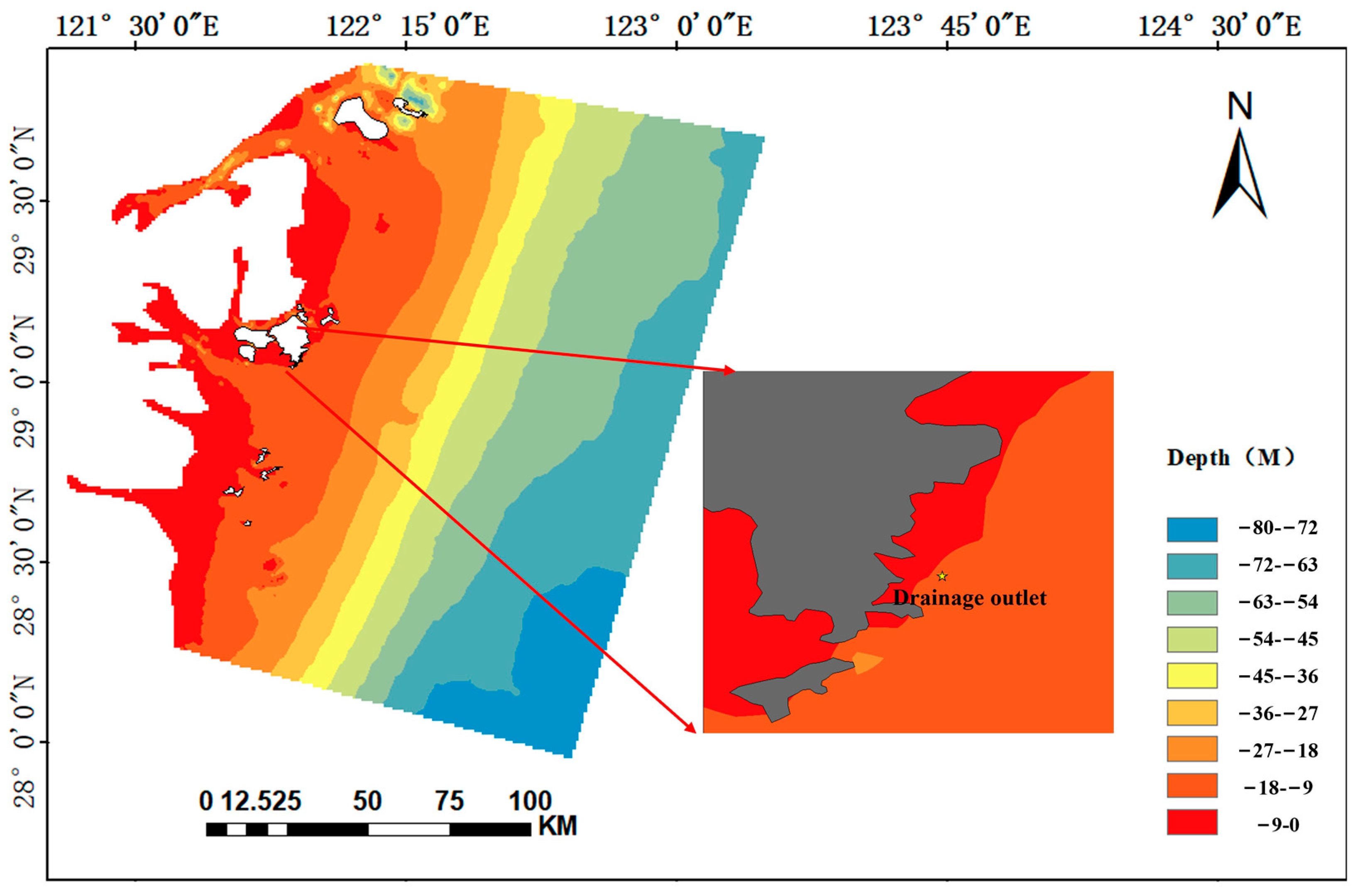

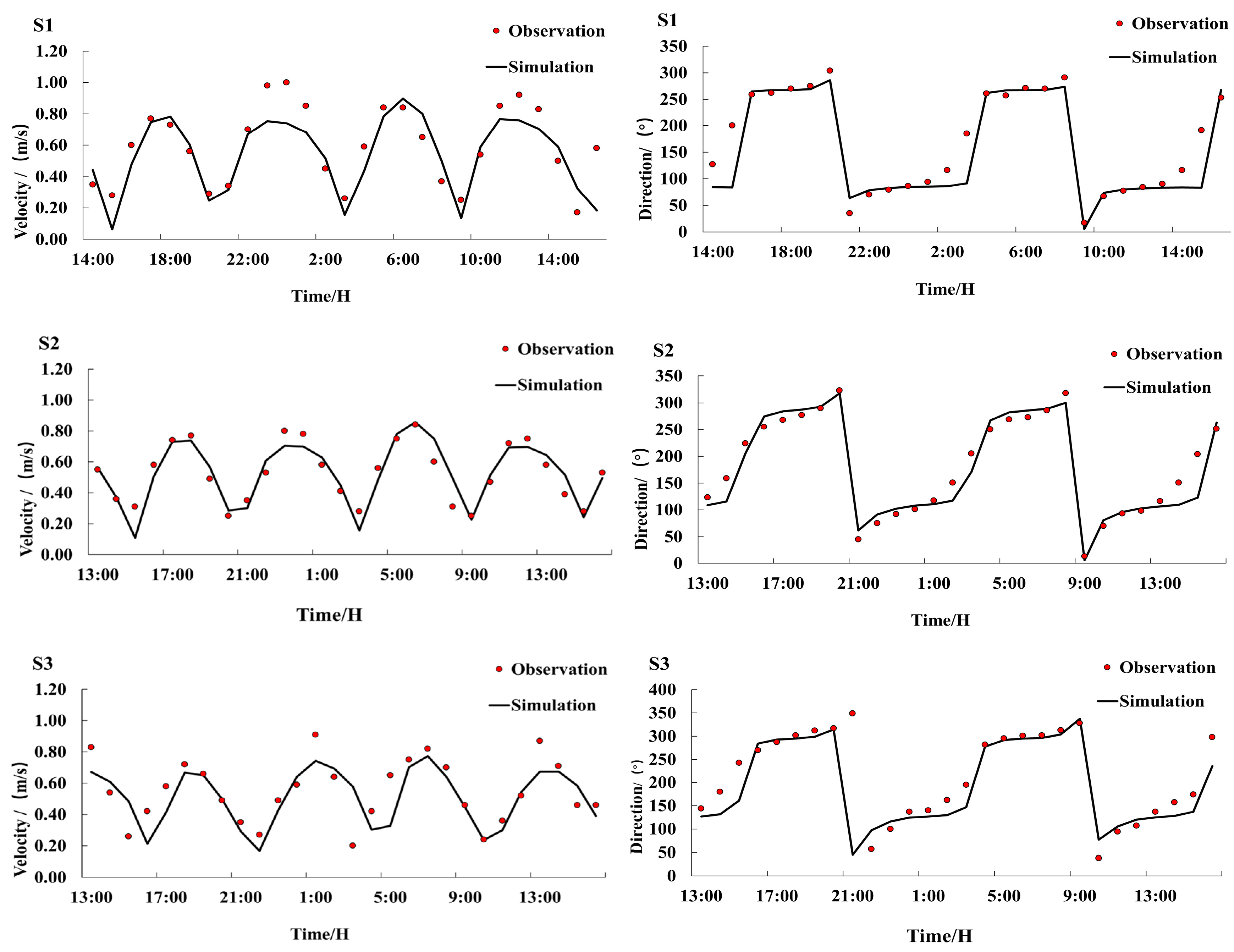


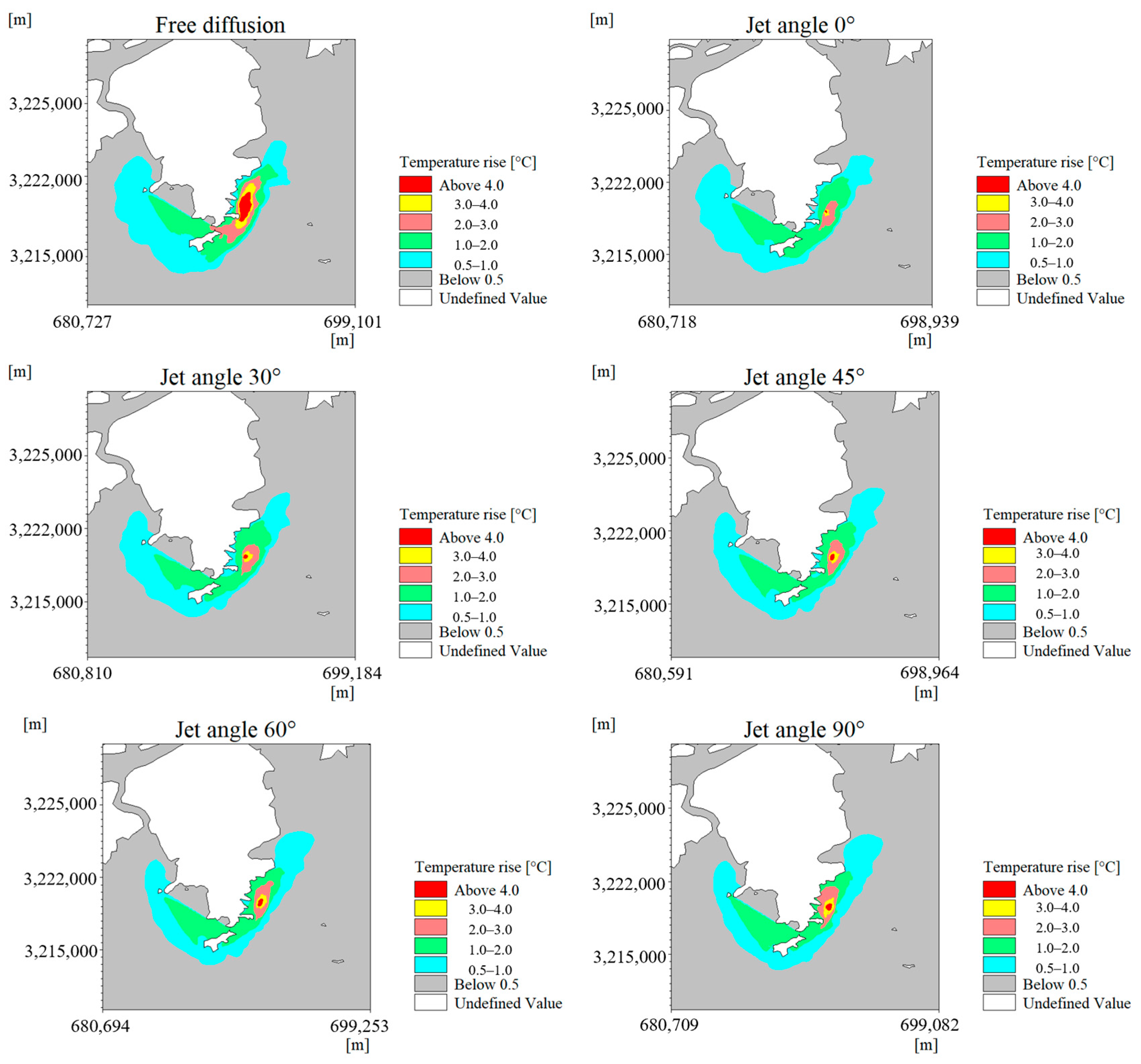

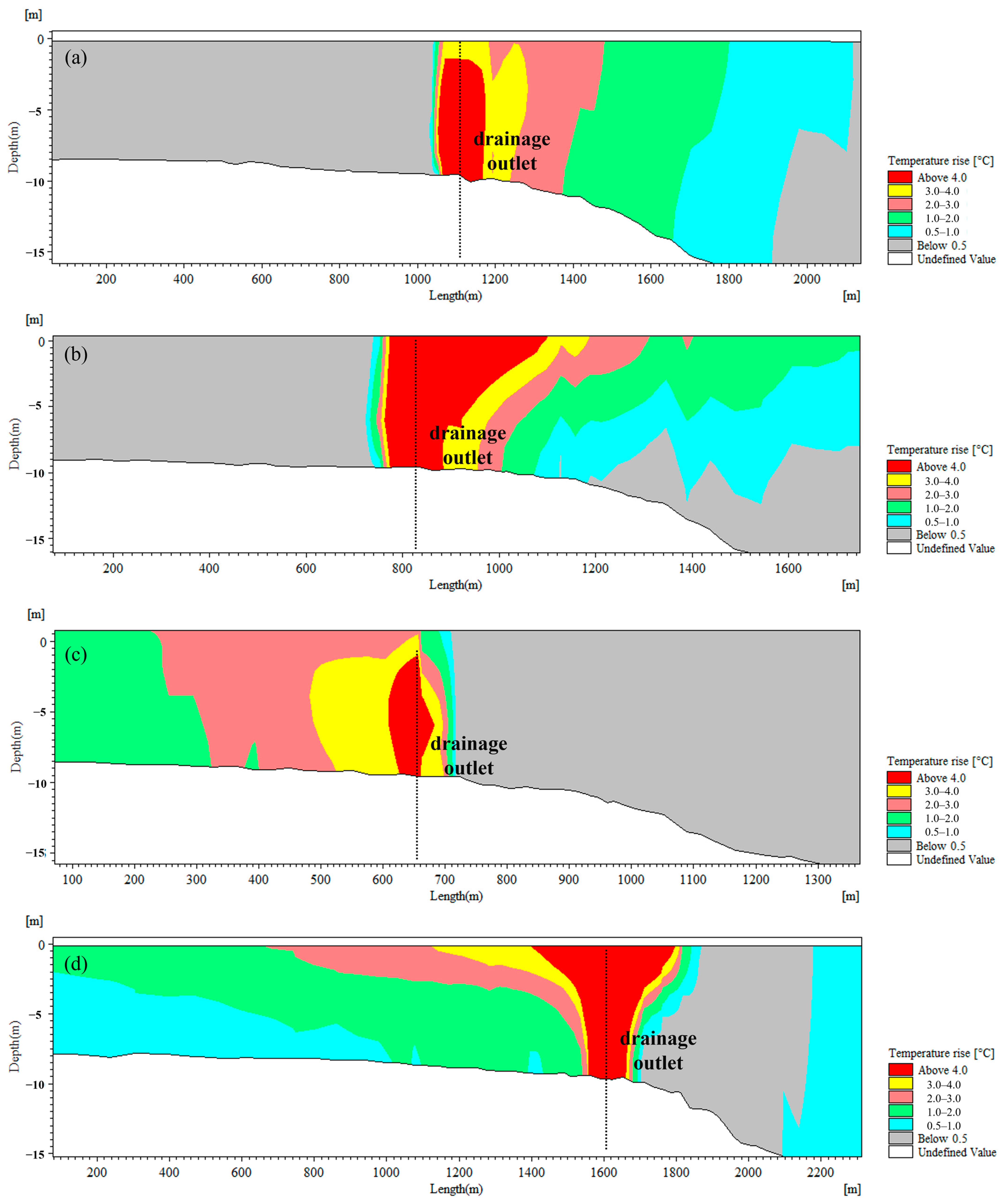
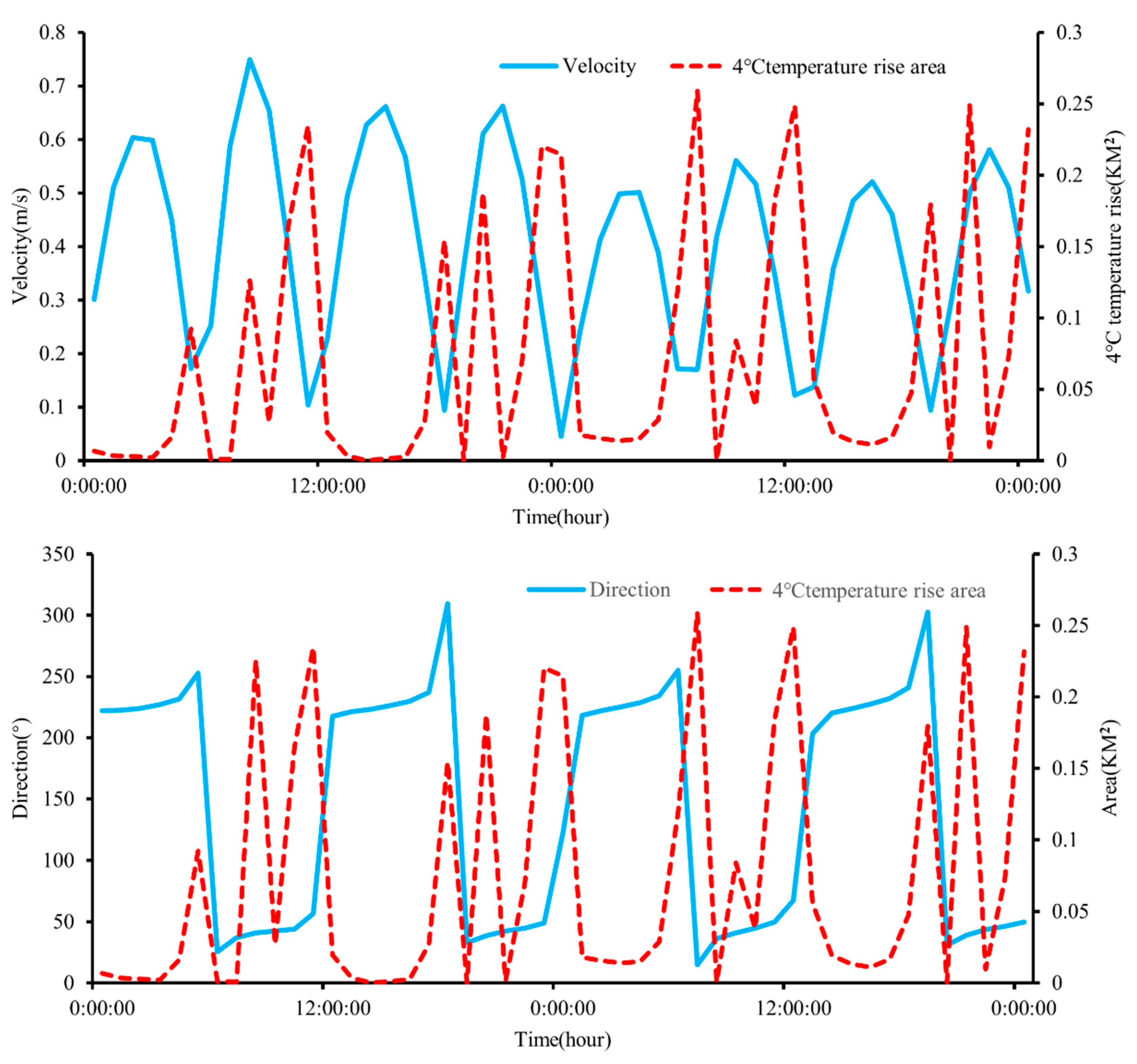
| Key Parameter | Value |
|---|---|
| Laten heat | 20 W/m2 °C |
| Sensible heat | 12 W/m2 °C |
| Short wave radiation | −17 W/m2 °C |
| Long wave radiation | 30 W/m2 °C |
| Air temperature | 32 °C |
| Sea surface temperature | 30 °C |
| Wind speed at 1.5 m above sea level | 3.32 m/s |
| Design temperature rise | 8.2 °C |
| Stations Name | Evaluation Itmes | Skill Value | Evaluation Results |
|---|---|---|---|
| W1 | Water level | 0.7 | Excellent |
| W2 | 0.7 | Excellent | |
| S1 | Flow velocity | 0.8 | Excellent |
| Flow direction | 1 | Excellent | |
| S2 | Flow velocity | 0.9 | Excellent |
| Flow direction | 1 | Excellent | |
| S3 | Flow velocity | 0.9 | Excellent |
| Flow direction | 0.9 | Excellent |
| Operating Conditions | Jet Angle (°) | Jet Speeds (m/s) | Outlet Location (m) |
|---|---|---|---|
| Operating Conditions 1 | Free Diffusion | 0 | −7.5 |
| Operating Conditions 2 | 0° | 1.12 | −7.5 |
| Operating Conditions 3 | 30° | 1.12 | −7.5 |
| Operating Conditions 4 | 45° | 1.12 | −7.5 |
| Operating Conditions 5 | 60° | 1.12 | −7.5 |
| Operating Conditions 6 | 90° | 1.12 | −7.5 |
| Jet Angles | Temperature Rise Area (km2) | |||||
| 0.5 (°C) | 1 (°C) | 2 (°C) | 3 (°C) | 4 (°C) | ||
| Free Diffusion | Surface layer | 47.52 | 17.75 | 5.89 | 2.62 | 1.31 |
| Middle layer | 44.00 | 12.16 | 0.55 | 0.23 | 0.13 | |
| bottom layer | 41.47 | 8.53 | 0.17 | 0.09 | 0.05 | |
| Projection plane | 47.52 | 17.82 | 5.89 | 2.62 | 1.31 | |
| 0° | Surface layer | 40.16 | 14.83 | 1.29 | 0.02 | 0.00 |
| Middle layer | 38.22 | 12.53 | 0.72 | 0.09 | 0.01 | |
| bottom layer | 37.87 | 12.10 | 0.64 | 0.10 | 0.02 | |
| Projection plane | 40.68 | 14.97 | 1.32 | 0.13 | 0.03 | |
| 30° | Surface layer | 36.73 | 13.64 | 1.74 | 0.34 | 0.07 |
| Middle layer | 35.90 | 12.40 | 0.83 | 0.11 | 0.03 | |
| bottom layer | 34.99 | 11.17 | 0.38 | 0.05 | 0.01 | |
| Projection plane | 37.03 | 13.64 | 1.76 | 0.35 | 0.07 | |
| Jet Angles | Temperature Rise Area (km2) | |||||
| 0.5 (°C) | 1 (°C) | 2 (°C) | 3 (°C) | 4 (°C) | ||
| 45° | Surface layer | 35.51 | 13.84 | 1.94 | 0.40 | 0.11 |
| Middle layer | 35.03 | 12.81 | 1.04 | 0.21 | 0.06 | |
| bottom layer | 34.21 | 11.01 | 0.42 | 0.07 | 0.01 | |
| Projection plane | 35.68 | 13.84 | 1.94 | 0.40 | 0.11 | |
| 60° | Surface layer | 36.22 | 13.68 | 2.16 | 0.54 | 0.15 |
| Middle layer | 35.82 | 12.90 | 1.33 | 0.33 | 0.08 | |
| bottom layer | 35.06 | 11.57 | 0.67 | 0.14 | 0.01 | |
| Projection plane | 36.51 | 13.73 | 2.16 | 0.54 | 0.15 | |
| 90° | Surface layer | 35.79 | 13.84 | 2.57 | 0.67 | 0.16 |
| Middle layer | 35.31 | 13.00 | 1.75 | 0.38 | 0.09 | |
| bottom layer | 34.50 | 11.88 | 0.70 | 0.16 | 0.01 | |
| Projection plane | 35.92 | 13.94 | 2.57 | 0.67 | 0.16 | |
Disclaimer/Publisher’s Note: The statements, opinions and data contained in all publications are solely those of the individual author(s) and contributor(s) and not of MDPI and/or the editor(s). MDPI and/or the editor(s) disclaim responsibility for any injury to people or property resulting from any ideas, methods, instructions or products referred to in the content. |
© 2025 by the authors. Licensee MDPI, Basel, Switzerland. This article is an open access article distributed under the terms and conditions of the Creative Commons Attribution (CC BY) license (https://creativecommons.org/licenses/by/4.0/).
Share and Cite
Li, L.; Shi, H.; Xue, H.; Wang, Q.; Zhan, C. Numerical Investigation of Jet Angle Effects on Thermal Dispersion Characteristics in Coastal Waters. J. Mar. Sci. Eng. 2025, 13, 931. https://doi.org/10.3390/jmse13050931
Li L, Shi H, Xue H, Wang Q, Zhan C. Numerical Investigation of Jet Angle Effects on Thermal Dispersion Characteristics in Coastal Waters. Journal of Marine Science and Engineering. 2025; 13(5):931. https://doi.org/10.3390/jmse13050931
Chicago/Turabian StyleLi, Longsheng, Hongyuan Shi, Huaiyuan Xue, Qing Wang, and Chao Zhan. 2025. "Numerical Investigation of Jet Angle Effects on Thermal Dispersion Characteristics in Coastal Waters" Journal of Marine Science and Engineering 13, no. 5: 931. https://doi.org/10.3390/jmse13050931
APA StyleLi, L., Shi, H., Xue, H., Wang, Q., & Zhan, C. (2025). Numerical Investigation of Jet Angle Effects on Thermal Dispersion Characteristics in Coastal Waters. Journal of Marine Science and Engineering, 13(5), 931. https://doi.org/10.3390/jmse13050931





